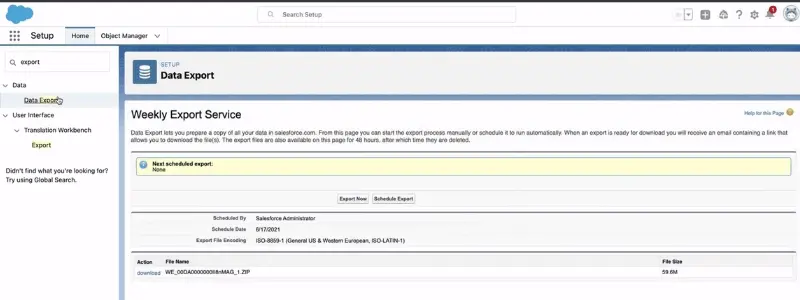Salesforce Data Export Options: A Complete Guide
Companies use Salesforce data export to back up their sales pipeline data. Many Admins use native tools like Data Export Service and Data Loader.
However, cybersecurity experts claim that these applications do not meet the business and operational needs behind data export and import. Learn how to export Salesforce data using native and third-party tools and which method is the best.
Understanding Salesforce data export and import
Before covering the methods of Salesforce data export and available tools, let’s first discuss what it is and its purpose. It will help us critically assess the methods and understand the criteria for picking the right tools.
The primary purpose of Salesforce data export is to back up the information stored in the application. This data is critical for the organization’s sales pipeline and, thus, revenue generation.
Another instance of Salesforce data export is transferring data from one organization to another, for example, for Sandbox Seeding.
Export Salesforce data for backup
Salesforce data export for backup purposes has to meet the following criteria:
Frequency
To meet the company’s Recovery Point Objective, Admins should export data regularly. Depending on the size of the sales team and the sales cycle speed, the frequency might differ for various companies.
Cybersecurity experts emphasize that Admins should export data from the CRM at least once a day.
Speed of Salesforce Data export and import
Speed of backup and recovery impacts the operations of a sales team. This is especially critical in the case of data loss. Slow recovery leads to more extended downtime.
Automation
Automating Salesforce data export will make companies less prone to human error.
Data types
Salesforce has three types of data: objects, files, and metadata. All these types are crucial for the seamless performance of the CRM. No native Salesforce tool exports all types of data.
Recovery ease
The possibility of finding a single entry to import back into Salesforce determines the ease of recovery.
Data loss
The security of the data you export from Salesforce is critical. If you can’t ensure it is protected from loss, your company might face severe problems with the revenue-generating process and have compliance issues.
Other important aspects to look for in tools:
- Pricing
- The integration with other SaaS tools
- The availability of additional functionality, for example, compare.
- Storage: where your data is stored and how safe it is.
Data transfer
Salesforce data export for transferring data between orgs has much fewer criteria:
- Speed
- Data types
- Usability
Now, let’s examine how the available tools meet these criteria.
Salesforce Data Export Service
Salesforce data export service is a legacy tool enabling your company to download its data as a CSV file. It has several serious limitations and drawbacks make it unsuitable for modern business needs.
However, if you don’t have a reliable third-party Salesforce backup, it is better than not exporting any data.
Salesforce Data Export Service Main Info
The tool is available on All Editions except database.com. Remember that the data export frequency differs for different editions (see Limitations below).
You need User permission (weekly data export) to complete data export.
Type of data exported: Objects and Files. It does not include objects in recycle bin.
Format of data: Salesforce Data Export Service creates a CSV file and archives it in zip files that you can download within two days from the creation.
How to export data from Salesforce using Salesforce Data Export Service
1. In your Salesforce, go to the Setup page (find it in the drop-down menu by clicking the gear icon).
2. Type in Data Export in the search field and click on the respective search result. You will get to the Salesforce Data Export Service.
3. Now you have two options:
- Immediate download (click Export Now)
- Delayed download (click Schedule Export)
Remember that time limitations on data export might prevent you from completing the Immediate download (see Limitations below).
4. Regardless of your choice, you will be redirected to the Export page. Set the data export parameters like encoding and types of data. At this stage, you can additionally include Files in your download. However, it can substantially extend the waiting period.
Note there’s Replace carriage returns with spaces option. If you don’t tick this box, importing the file back to Salesforce will be impossible.
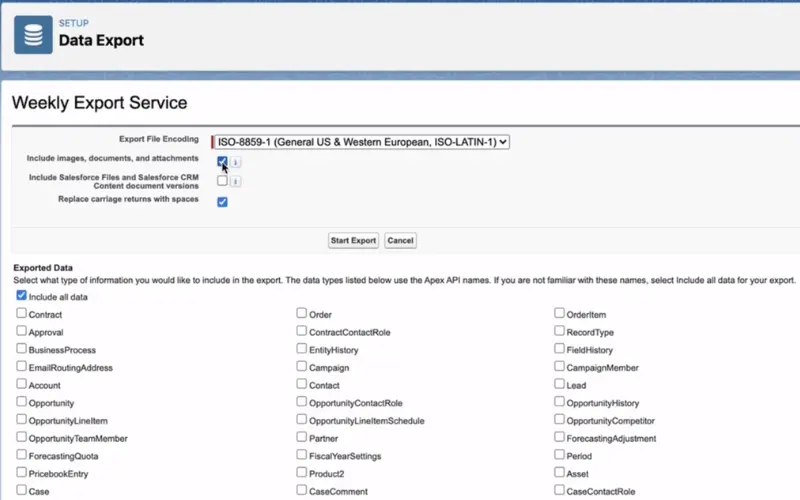
5. Pick the time and frequency of your data import. The frequency is not available in all editions (see limitations). Click Save.
6. Important step! Once Salesforce has completed your request, it will send you an email with the link to your zip files. Click on that link and download it within 48 hours upon receiving it. Afterward, it will be deleted automatically. So, if you don’t do it, you will lose the data in it.
Salesforce Data Export Service limitations
As mentioned above, Salesforce Data Export Service has impeding limitations:
- Frequency
The backup frequency is 29 days for all editions and 7 days for Enterprise, Performance, and Unlimited Editions.
- Data types
The tool doesn’t export Metadata, which is unsuitable for companies with Development teams working on Salesforce.
- Automation
Data Export Service has limited automation capabilities. Although you can schedule the creation of a CSV file, you still need to look for an email or a page in Salesforce to download the file manually.
- Speed
If you study the Salesforce FAQs on this tool, you will see that many questions are related to the postponement of data export (e.g., ‘Why does it take so long?’ and ‘What can I do to make it faster?’). Salesforce admits that it can take up to one week to form that file due to large queues.
- User-unfriendly recovery
You get multiple CSV files in an archive. Even more so, you can end up getting multiple Zip files. This makes data discoverability and recovery a very tedious process.
- Data loss
Incredibly, this tool doesn’t entirely protect your company from data loss. If you haven’t downloaded your files due to an emergency or because the email has been lost in your inbox, they’ll be permanently deleted.
- No SLA
Salesforce provides no Service Level Agreement for Data export service.
Salesforce Data Loader
Yet another legacy tool, Salesforce Data Loader, has more limitations than Data Export Service. At the same time, it enables companies to not only export Salesforce Data but also import it.
The tool will make you do more manual work and perform on a limited number of editions.
Salesforce Data Loader Main Info
Data Loader is an on-prem solution for Windows or Mac.
The tool is available in Enterprise, Performance, Unlimited, and Developer Editions.
Type of data exported: Objects and Files.
Data export is on-demand only, with no schedule.
Format of data: Salesforce Data Loader creates a CSV file.
It also can export data from your recycled bin and archived data.
How to export Salesforce data using Salesforce Data Loader
1. Click Export in your Data Loader. For exporting archived data and data from the recycle bin, click Export All.
2. Perform Login if necessary. The pop-up window will appear, enabling you to choose the exported data settings.
Choose the Object you want to export. Unfortunately, you can only download one object at a time. Note there’s a Show All Objects option available.
3. Click Browse to assign location download. You will be redirected to the next step, where you can set the conditions for your exported data.
For example, you can limit the Queries and set conditions for them. Upon filling out the necessary data, click Finish.
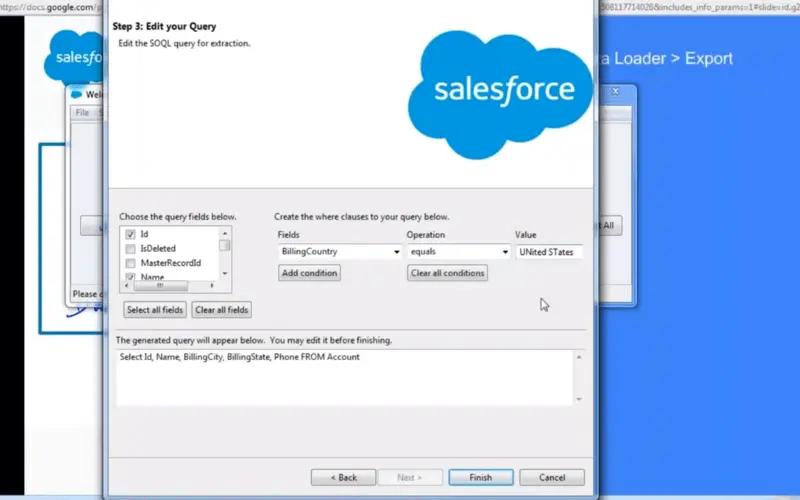
6. Upon completion of the operation, you can export other objects of your choice.
Limitations to exporting data from Salesforce
Let’s now talk about the limitations of Data Loader that make it an uncomfortable tool for businesses.
Frequency and Automation
Although there is no limitation on how often you can use Data loader, its automation capabilities are non-existent. You’ll have to do many things manually.
Data types
You will not be able to export metadata or files.
Data loss
Data loss in this tool can occur mostly because of human error.
Other ways to export data from Salesforce
Salesforce data export using Google Sheets
You can export Salesforce data directly into Google Sheets. However, you will need an add-on and connect it to your CRM (learn why Google Workspace Apps are risky). Once you’ve done it, you can start data export:
- Go to Google Sheets page. In the right corner, press on the nine dots that represent Google Apps.
- Find the app (Data Connector for Salesforce) in the drop-down menu and open it.
- You will be presented with two data export options: Reports and Import. The latter name is a bit confusing. However, it just means transferring Objects from Salesforce to Google Sheets. This function uses a query builder or SQL.
- You will be redirected to the respective window. There, you can configure your data export using the search bar. Just type in the name of the data entry you want to export.
- Confirm your choice.
Limitations of using Google Sheets for data export in Salesforce
There are two available types of data for export: Objects and Reports.
Data export is limited to 5 data entries per action (fields, filters, or objects).
Data loss is probable. Though Google
Export data from Salesforce into Excel using Excel Original Interface
You can use Excel Original Interface to download data from Salesforce. The benefit of this type of data export is the opportunity to export reports. Here’s how to export data with this tool:
- Create a new Excel doc or open the one to which you want to download your data.
- In the upper menu bar, click on Data and then choose New Query.
- A drop-down menu will appear. Click From Online Services.
- It will trigger a side menu with two Salesforce Data Export Options: Reports and Objects. Pick the one you need.
- In the pop-up window, log in to your Salesforce account. You will be redirected to the page where you can pick the objects or reports you want to export. This function enables you to also pick multiple objects.
- Click Load. The data will be exported directly to the Excel file.
Limitations to exporting Salesforce data using Excel Original Interface
You need to connect your Salesforce with Microsoft 365. Only two Microsoft editions provide a tool to support this function: Professional and Pro Plus. This can be fixed by installing Excel add-ons.
Data types are limited to Objects and reports.
Data loss depends on your available backup for PC since you download the data on your computer.
Salesforce data export using third-party backup solution SpinOne
SpinOne is a SaaS data protection platform that backs up Salesforce data and metadata. It’s a cloud application, so you can use it anywhere. Its many functions help you better manage your Salesforce backed-up data.
Companies can use it for data export: the tool lets you easily download CSV files from the CRM. Let’s take a look at how to do it.
Export Data from Salesforce using SpinOne
1. Log in to your SpinOne account. If you have SpinOne for Microsoft 365 or Google Workspace, you’ll need to open the Salesforce environment in the top right corner.
2. In the left Menu, find the Backup and Restoration Section and click on Salesforce. You will be redirected to the page with all your backed-up Salesforce organizations, including your Sandbox.
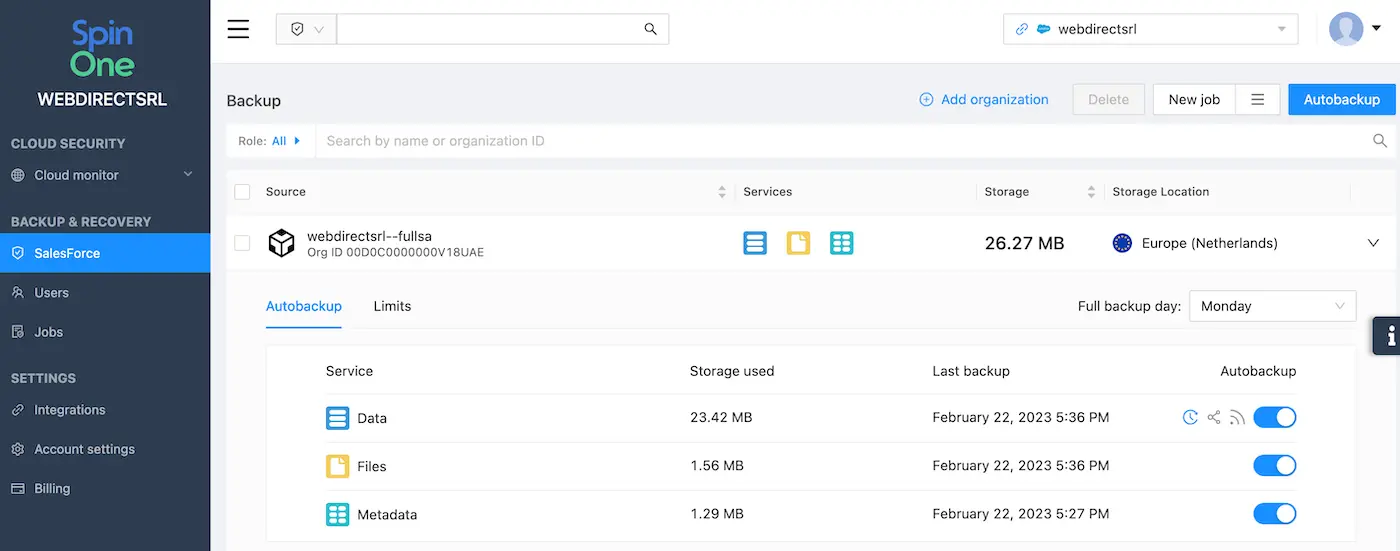
3. Click on the org you need to export files from. In the drop-down tab, you will see three types of data that SpinOne has backed up for you: Data, Files, and Metadata.
The list will also show the size of the backed-up data, the date of the last backup, and the auto-backup status.
4. Click on the icon of the data type. You will be redirected to the respective page. There you will see the list of Salesforce data entries with the information on their quantity, changed, added, and removed records.
5. Click the big blue button in the top right corner (Version + date). In the pop-up window, pick the snapshot of your data from a particular day and confirm your choice.
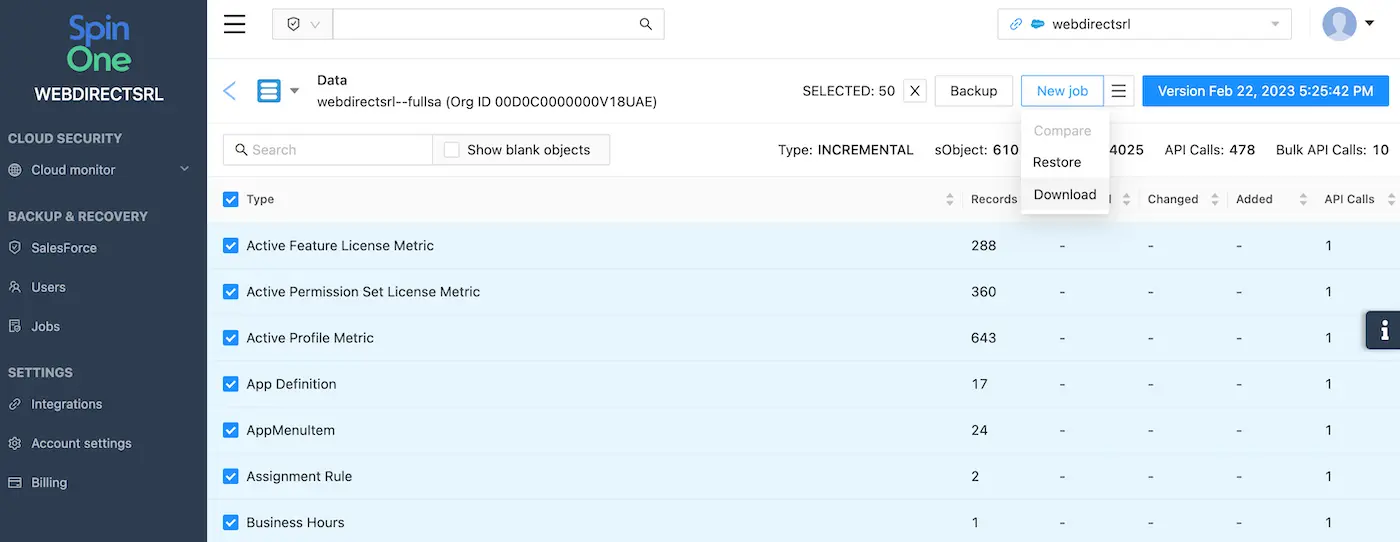
6. To export all the entries, tick the box next to Type. Otherwise, manually pick those entries you wish to export.
7. Click New Job (next to the Version button) and choose Download from the drop-down menu. You will be redirected to the Jobs section, where you can watch the taskbar.
If you need to download other Versions or other Data types like Files or Metadata, go back to the Salesforce section of SpinOne and repeat an action.
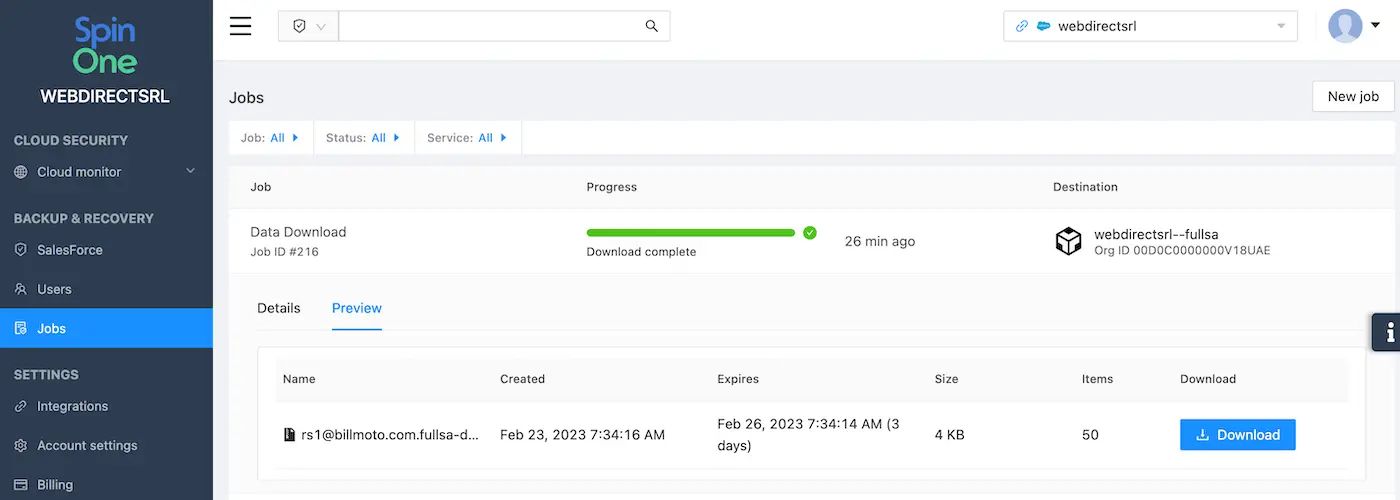
8. Once the forming of the CSV file is complete, click on the Job (Data Download). In the drop-down tab, click Preview and then Download to export files.
Why use SpinOne for Salesforce data export
SpinOne is the best choice regarding data export and backup for your Salesforce environment.
Frequency and automation
Admins can set 1x or 3x daily backups for Salesforce. The backups are 100% automated and do not depend on human errors or emergencies. Meanwhile, Data Export isn’t limited. You can download data from Salesforce as many times a day as possible with different organizations, types of data, and time snapshots.
All types of data and all environments
SpinOne for Salesforce backs up not only Files and Objects but also metadata. In addition to that, it is not limited to the working environment. You can also use it with your Sandbox.
No Data Loss
Because SpinOne functions like a backup tool, it creates multiple copies of your Salesforce organizations. If the information was deleted long ago, you could always find a version of your data from the past and recover it.
Speed
Speed of performance in Salesforce is slow for many tools because of the API limitations. Our developers found a way to solve this problem with the smart use of 2 types of APIs.
Data Recovery
Because SpinOne stores all the data entries in the cloud, our users do not need to rely on exported CSV files for data recovery. Instead, they can directly retrieve the lost data from SpinOne, making it a superior data recovery tool.
Compare function
This function enables you to compare different orgs as well as versions to identify if your company lost any entries.
Other benefits
Other benefits of using SpinOne for Salesforce include:
- Single pane of glass: Admins can control the backup process and data export from one tool
- Unlimited storage.
- 99% SLA
- Keeping backed-up data in GCP, AWS, Azure
- Integration with other SaaS products like Google Workspace and Microsoft 365.
Wrapping up
There are plenty of tools that Salesforce Admins can apply to perform data export. Native solutions and some third-party tools have natural limits that make the efficiency of their use.
These limitations include low-performance speed, lack of data loss prevention mechanisms, absence or low level of automation, and no condition for performing data exports frequently.
There are three main types of third-party tools:
- Downloaders that are limited only to performing data export functions.
- Add-ons for the sheets tools like Excel or Google Sheets enable connecting Salesforce with Microsoft 365 or Google Workspace.
- Salesforce backup solutions enable backing up data and downloading the current and past versions of data.
Most tools only export one or two data types, like Objects or reports. However, some tools also provide metadata backup and export. Finally, a minority of tools work with the Sandbox environment.
Experts believe that tools encompassing multiple data protection and management functions benefit companies more. They suggest against the manual performance of most functions and recommend third-party tools like SpinOne to boost productivity and strengthen cybersecurity.
The modern business environment is fast-paced. And to keep up, your revenue generation team and your CRM must perform at their highest potential.
Was this helpful?
How Can You Maximize SaaS Security Benefits?
Let's get started with a live demo
Latest blog posts
Why a Reliable Backup Plan is Your Best Defense Against Cybersecuri...
…and the Most Boring Way to Protect Your Organization I’ve written about the importance of...
Why Google Drive Backups Are Important
Google Drive offers customers a unique blend of robust security features to keep their data...
Evaluating the Best Backup Services: What to Look For and Popular O...
If you’re here right now you’ve probably realized how important it is to backup your...
